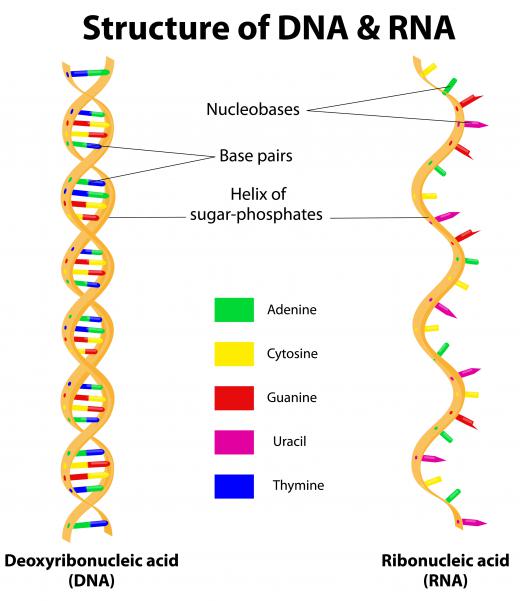What is RNA?
 Mary McMahon
Mary McMahon
Ribonucleic acid (RNA) is a chain of nucleotides present in the cells of all life. This chain has a number of important functions for living organisms, ranging from the regulation of gene expression to assistance with copying genes. Severo Ochoa, Robert Holley, and Carl Woese all played critical roles in discovering RNA and understanding how it worked, and more research is constantly being performed.
Many people are familiar with deoxyribonucleic acid (DNA), a nucleic acid which is often referred to as the “building blocks of life” because it contains the genetic material for its parent organism. RNA is equally important, even if it is lesser known, because it plays a critical role in helping DNA to copy and express genes, and to transport genetic material around in the cell. RNA also has a number of independent functions which are no less important.

RNA strands have a backbone made from groups of phosphates and ribose, to which four bases can attach. The four bases are adenine, cytosine, guanine, and uracil. Unlike DNA, RNA consists of a single strand, with strands folding to compact themselves into the tight space of the cell. Many viruses rely on RNA to carry their genetic material, using it to hijack the DNA of infected cells in order to force those cells to do what the virus wants them to do.
This nucleic acid plays a role in the synthesis of proteins, the duplication of genetic material, gene expression, and gene regulation, among other things. There are a number of different types, including ribosomal RNA (rRNA), transfer RNA (tRNA), and messenger RNA (mRNA), all of which have slightly different functions. Studies on these different types sometimes reveal interesting information. rRNA, for example, undergoes very few changes over the millennia, so it can be used to trace the relationships between different organisms, looking for common or divergent ancestors.
DNA plays a role in the synthesis of RNA. Essentially, DNA contains the blueprints for making RNA, so when the cell requires more, it pulls up the necessary information in the DNA and gets to work. This process is known as “transcription,” referencing the fact that the information is basically copied from one molecule to another. Some very sneaky viruses, like HIV, are capable of reverse transcription, which means that they can translate RNA into DNA. Drugs which target such viruses often focus on the reverse transcription capability of the virus, working to block it so that it cannot perform this function.
AS FEATURED ON:
AS FEATURED ON:











Discussion Comments
does RNA help DNA to copy and transfer information?
Does RNA control the endocrine system with all of the turning on and shutting off of the glands?
@calabama71: No, actually RNA is a single helix. DNA is a double helix but RNA is a single helix, single chain spiral.
Is RNA a double helix?
Post your comments